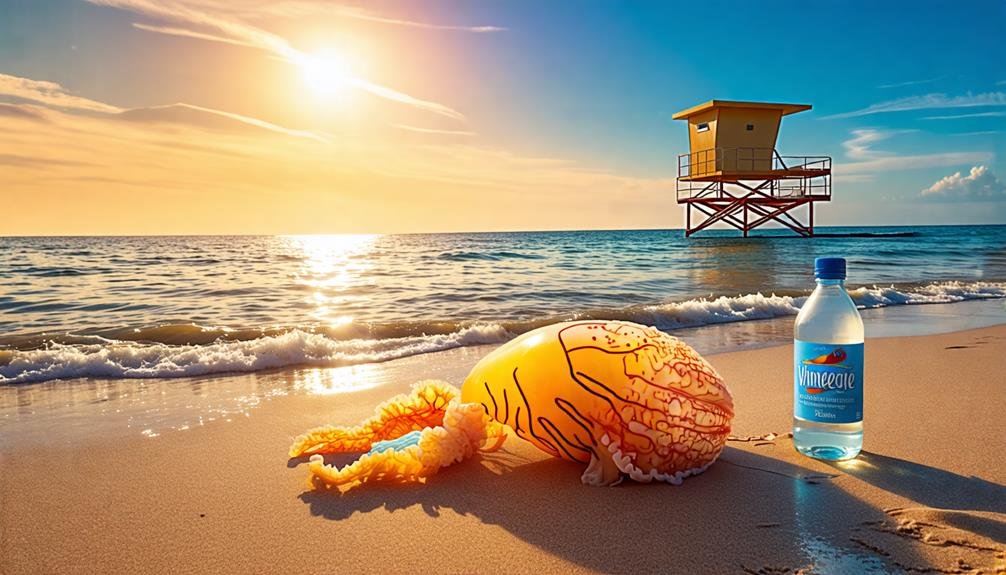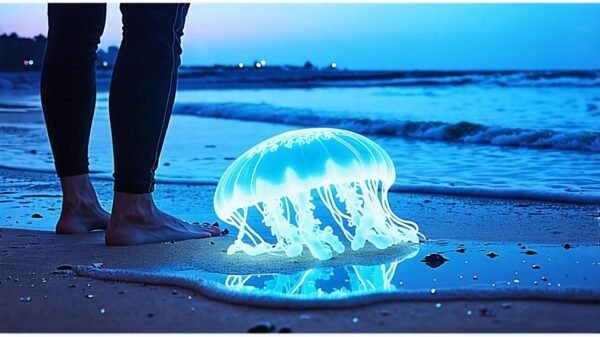If you're stung by a jellyfish, act quickly to reduce pain and prevent further injury. Rinse the affected area with white vinegar to neutralize the venom, and use tweezers to carefully remove any tentacles. Soak the sting site in hot water for 20 to 45 minutes, as heat can ease pain and deactivate remaining stingers. Consider applying a hot pack for extra relief. If symptoms worsen, or if you notice signs of an allergic reaction, seek medical help immediately. Having a primary aid kit with vinegar and other crucial items can make a big difference in managing jellyfish stings effectively. More helpful tips await.
Recognizing a Jellyfish Sting
Recognizing a jellyfish sting is crucial for timely treatment. Symptoms usually include immediate pain, burning sensations, and visible red welts on the skin. When swimming or enjoying the ocean, being aware of these signs indicates the presence of venom from the jellyfish's tentacles.
If you experience sharp pain and skin irritation, you may be dealing with a jellyfish sting. The affected area may become inflamed, showing small, raised welts. Identifying these symptoms allows you to act quickly and seek appropriate care to relieve discomfort.
An important step in managing a jellyfish sting is the application of vinegar. Using undiluted vinegar on the sting site can help reduce the venom's potency. This action is crucial as it neutralizes the stingers and diminishes further irritation. Remember, the sooner you identify a jellyfish sting and initiate treatment, the better your chances of a swift recovery. By staying informed and observant, you can confidently navigate potential jellyfish encounters and enjoy your time in the water while prioritizing your safety.
Immediate Steps to Take
Upon encountering a jellyfish sting, prompt action is crucial to alleviate discomfort and prevent further issues. The first step in effective treatment is to rinse the affected area with white vinegar. Vinegar helps neutralize the jellyfish venom and diminishes its potency. Avoid rinsing with fresh water, as this can cause additional venom release from the tentacle remnants.
Next, if any tentacles are still attached, carefully remove them with tweezers. Do not use your fingers, as this can lead to more venom entering your skin. After addressing the tentacles, immerse the stung area in hot water. Soaking in water heated to approximately 104°F (40°C) for a minimum of 30 minutes can deactivate remaining stingers and facilitate healing.
If soaking is not feasible, applying a hot pack can serve as a temporary solution. This immediate response alleviates pain and reduces the likelihood of complications. Remember, while jellyfish stings may be alarming, adhering to these steps can help you recover and enjoy the ocean again. Always seek medical assistance if symptoms escalate or if an allergic reaction occurs.
Importance of Vinegar Treatment

Vinegar is essential in treating jellyfish stings, as it effectively neutralizes venom and alleviates pain. When an individual is stung by a jellyfish, quick action is crucial for safety in ocean environments. Direct application of undiluted vinegar to the affected area inactivates the venomous nematocysts that may still be present. This straightforward beach remedy can significantly lessen discomfort and prevent additional complications.
Studies indicate that vinegar outperforms other common solutions, such as lemon juice or alcohol, which might actually exacerbate the sting. For example, prompt vinegar application can help mitigate the burning sensation often associated with jellyfish stings. Remember, even after a sting, you can reclaim your enjoyment of the ocean with the right treatment.
Additionally, having a beach emergency kit is vital. This kit should contain vinegar, gloves, and tweezers for the safe removal of any tentacles. By recognizing the importance of vinegar treatment, you equip yourself with the skills to manage jellyfish stings effectively, ensuring your beach experiences remain safe and enjoyable.
Hot Water Soak Benefits
A hot water soak is a highly effective remedy for jellyfish stings, providing significant pain relief and promoting faster healing. When submerged in hot water, the heat helps deactivate the stingers that may still be present on the skin, reducing irritation and discomfort. This comforting soak can also improve the overall healing process, allowing the skin to recover more quickly and efficiently.
Pain Relief Mechanism
Soaking the stung body part in warm water for at least half an hour effectively neutralizes residual stingers and significantly reduces discomfort related to jellyfish encounters. This method operates by applying heat, which assists in breaking down the toxic proteins and decreasing swelling. The warmth enhances circulation, facilitating recovery and activating the body's natural healing mechanisms.
When applying warm water, it's crucial to maintain a comfortable temperature, ideally between 104°F to 113°F (40°C to 45°C), as overly hot water can lead to skin damage. This comforting soak not only alleviates pain but also eases muscle tension, which may occur following a sting.
Many individuals experience substantial relief after this treatment, allowing them to return to aquatic activities without persistent discomfort. Although the initial impact of a jellyfish sting can be distressing, recognizing the role of warm water in pain relief can empower you to manage the situation effectively. Prompt treatment is essential, so act swiftly to lessen discomfort and enhance healing.
Stinger Deactivation Process
The application of hot water plays a vital role in the deactivation process of jellyfish stingers, as it effectively neutralizes residual venom and aids in healing. Soaking the affected skin in hot water for a minimum of 30 minutes can significantly reduce pain and discomfort. This approach works by denaturing the proteins in the venom, which diminishes its harmful effects on the body.
Consider these advantages of a hot water soak:
- Venom Neutralization: Hot water breaks down the venom proteins, lowering their potency.
- Pain Relief: The warmth soothes the affected skin, offering immediate comfort.
After a jellyfish sting, it is crucial to act quickly. Start by rinsing the sting site with vinegar to neutralize the venom, then follow up with the hot water soak. This combination can effectively manage symptoms and promote a quicker recovery. Always prioritize your health and seek medical attention if severe reactions arise. By taking these steps, you can confidently and safely handle jellyfish stings, allowing you to enjoy the ocean with peace of mind.
Enhanced Healing Time
A hot water soak not only alleviates immediate discomfort from a jellyfish sting but also promotes healing by enhancing blood circulation and speeding up tissue recovery. When you immerse the affected area in hot water, ideally between 104°F and 113°F (40°C to 45°C), it helps deactivate any lingering nematocysts and diminishes pain. This approach increases blood flow, delivering essential nutrients and oxygen to the injured tissues, aiding in their repair.
For optimal results, aim for a hot water soak lasting at least 30 minutes. This duration allows your body to effectively neutralize the toxin, promoting quicker healing. While the initial discomfort may be severe, this treatment can significantly reduce pain and shorten recovery time.
After soaking, applying soothing ointments like Cortizone-10 can further facilitate healing and alleviate itching. Additionally, staying hydrated and resting post-sting can enhance overall recovery. With appropriate care, most jellyfish stings heal within a week, enabling you to enjoy the pleasures of the water once again.
Creating a First Aid Kit

Creating a well-equipped initial aid kit is crucial for anyone spending time near the ocean, especially where jellyfish may be present. Necessary items include vinegar to neutralize venom, gauze and gloves for wound care, and tweezers for safe tentacle removal. Moreover, having an oral antihistamine on hand can help manage allergic reactions, while being attentive to beach safety tips guarantees a proactive approach to potential stings.
Essential Kit Items
A well-stocked initial aid kit for jellyfish stings should consist of essential items like Heinz vinegar, gauze pads, disposable gloves, tweezers, Neosporin antibiotic ointment, and Cortizone-10 hydrocortisone cream. These crucial components will enable you to respond effectively to a sting, promoting a smoother recovery process.
To enhance your first aid kit, consider incorporating these additional items:
- Heinz vinegar: This product is essential for neutralizing jellyfish venom and should be applied without delay.
- Tweezers: Use these to gently extract any tentacles without using your hands, minimizing the risk of further venom release.
Allergy Preparedness
Including allergy preparedness in your primary first aid kit is essential for managing allergic reactions to jellyfish stings. Having the right supplies can significantly impact your response to unexpected situations. Start by adding an oral antihistamine, such as Benadryl, to relieve symptoms like hives or itching. Additionally, include gauze and nitrile gloves for safe application of first aid, along with tweezers for careful removal of jellyfish tentacles.
Make sure to pack antibiotic ointment and Hydrocortisone cream to promote healing and reduce inflammation. Vinegar is a critical item in your kit, as it is the most effective treatment for jellyfish stings, helping to neutralize venom.
Knowing how to use these supplies is crucial. For example, if someone suffers a severe allergic reaction, being able to quickly administer the antihistamine can make a difference. Regularly inspect your kit to ensure all items are within expiration dates. Being prepared for jellyfish encounters allows you to enjoy the beach while feeling confident in your ability to respond effectively to stings and allergic reactions.
Beach Safety Tips
An effective beach safety kit should contain essential supplies to handle potential jellyfish stings and allergic reactions. Being prepared enhances your beach experience, allowing you to embrace the ocean's freedom without worry. Here are three crucial items to include in your first aid kit:
- Vinegar: This substance is vital for neutralizing jellyfish venom and should be applied immediately after a sting.
- Tweezers: Utilize these tools to gently remove any tentacles without further injecting venom.
In addition to these items, ensure you have gauze, disposable gloves, antibiotic ointment, and hydrocortisone cream for wound treatment. While enjoying the beach, remain alert for jellyfish and pay attention to any warning flags displayed. Most jellyfish stings heal within a week when treated appropriately. By maintaining a well-stocked first aid kit and understanding how to respond to stings, you can enjoy your beach outing confidently, knowing you are equipped for the unexpected. Remember, enjoying the beach entails both responsibility and awareness.
Handling Jellyfish Safely
Approaching jellyfish requires caution due to their ability to sting, even when washed ashore. To enjoy beach activities safely, stay alert to your environment. Look for warning signs or flags indicating jellyfish presence, and avoid areas where jellyfish are spotted.
When wading or swimming, refrain from touching jellyfish, as their tentacles can reach far beyond their bodies. If you spot a jellyfish, maintain a safe distance. If you encounter a washed-up jellyfish, do not handle it; these marine creatures can still sting, even when lifeless.
If you're using a Sea-Doo or participating in water sports, wear protective clothing like rash guards or swimsuits with long sleeves to minimize skin exposure. Familiarize yourself with jellyfish species found in your region, as some, like the box jellyfish, are particularly dangerous.
Understanding Allergic Reactions

Allergic reactions to jellyfish venom can show various symptoms, ranging from mild skin irritation to severe respiratory distress. Understanding these reactions is essential for effective treatment and reassurance. Individuals may experience hives, swelling, or difficulty breathing, which necessitates immediate medical attention.
It is important to identify the signs of an allergic reaction to jellyfish stings, as they can differ significantly. Key symptoms include:
- Dermatological reactions: Redness, itching, or hives may appear on the skin.
- Gastrointestinal distress: Symptoms such as nausea, vomiting, or abdominal pain can emerge.
If you or someone else exhibits signs of an allergic reaction, seeking help promptly is crucial. While most jellyfish stings heal within a week, allergic reactions can escalate rapidly, highlighting the need for vigilance. Remember, understanding allergic reactions equips you to respond confidently and effectively. By recognizing symptoms early, you can ensure a safer experience when engaging in ocean activities.
Long-Term Care and Healing
Recognizing the signs of an allergic reaction is crucial. Understanding the long-term management and recovery process after a jellyfish sting is equally important. After addressing the initial symptoms, it is vital to monitor the sting location for any indications of infection or atypical reactions. Most jellyfish stings heal within a week, but sensitivity or itching may persist for an extended period.
To facilitate recovery, keep the affected area clean and apply Neosporin if there are open wounds. Hydrocortisone cream can reduce itching and swelling. Additionally, taking Benadryl can help ease allergic reactions and discomfort. Staying hydrated with water is essential, as proper fluid intake supports your body's healing mechanisms.
If you encounter ongoing pain, swelling, or severe symptoms, seek advice from a medical professional. Listening to your body and seeking assistance when necessary is vital. Remember, each person's recovery journey is unique, and solutions effective for one individual may not be suitable for another. By adhering to these recommendations, you can concentrate on recovery and confidently return to enjoying aquatic activities.
Preventive Measures for Future Stings

Taking proactive measures can significantly reduce the chances of future jellyfish encounters while enjoying ocean activities. Understanding the factors that attract these creatures and implementing suitable precautions can enhance your beach experience. Here are some effective strategies to consider:
- Wear Protective Gear: Choose to wear a full wetsuit or a rash guard from brands like O'Neill or Rip Curl, which can create a protective barrier against jellyfish tentacles.
- Stay Updated: Before entering the water, check local marine reports for jellyfish activity and heed warning signs posted on the beach.

































